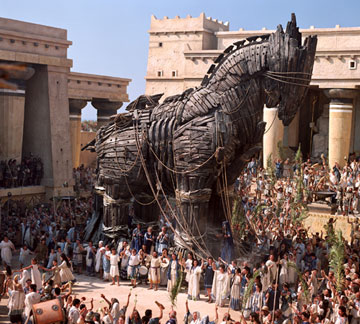Please click on the link to listen.
Following is the article used in the sermon.
It was gotten from americancatholic.org/newsletters/CU/ac100.asp
Bryan Denlinger | No Catholic RaptureBible Believers Fellowship
Those who are against the Pre-Tribulation Rapture doctrine, often claim that this teaching was developed by John Nelson Darby in the early 1800's. But what happens when we apply this same logic to the teaching that the Church goes through the Tribulation? Where did this teaching come from?
In this study we will look at proof that shows that the Roman Catholic church has believed and taught AGAINST the Pre-Trib. Rapture since 431 A.D. according to their own writings! You will see that the modern movement, that teaches that Christians will have to endure 7 years of the Great Tribulation, was founded by Roman Catholicism! |

For many American fundamentalist Christians, the Rapture forms part of the scenario of events that will happen at the end of the world. Read about Catholic teaching on the Rapture, the meaning and origin of the Rapture doctrine and the problems this teaching presents.
Catholic Update
Each issue carries an imprimatur from the Archdiocese of Cincinnati. Reprinting prohibited
Raptured or Not?
A Catholic Understanding
“What is the Catholic teaching on the Rapture?” It was over 30 years ago that a student in my Scripture class asked me that question. Drawing on all my years of Catholic education (kindergarten through the seminary and doctoral studies), I replied, “The what?” I had never heard of it.
In the intervening years, talk of the Rapture has become much more pervasive in our culture. Through radio and TV preachers, the Moral Majority movement of the 1970s and 1980s, the turn of the millennium in the year 2000, and the phenomenal success of the “Left Behind” series of novels (recently completed at volume 12 and earning a cover story in the May 24, 2004 issue of Newsweek magazine, it is likely that few Catholics today would share my response. They would, however, probably still be a bit puzzled by it, and ask another question as well, “Will we, as Catholics, share in the Rapture?”
In this Update we will address these questions. We will begin by looking at the meaning and origin of the Rapture doctrine. Then we will briefly consider the key biblical passage which is foundational to it. Finally, we will highlight some problem areas it presents.
SPONSORED LINKS
The Rapture doctrine: what and when?
But what do we mean by “the Rapture”? The word can be used in different ways. Spiritual writers have used it for mystical union with God, or our final sharing in God’s heavenly life. This is not the sense we are using it in here; we are using it in a much more specific way.
For many American fundamentalist Christians, the Rapture forms part of the scenario of events that will happen at the end of the world. While differences exist among various groups, the more common view goes like this: At the end, Jesus will come on the clouds of heaven and the righteous (“the saints”) will be raptured, that is, caught up into the air, to be with Christ. They will be separated from sinners who will remain on the earth to endure a period of great suffering (the Tribulation).
After this, Jesus will rule on earth for 1000 years (the Millennium); finally, then, Jesus comes at the end in judgment (the parousia) and will inaugurate the new heavens and the new earth. The Rapture is significant, then, as the first of the events that mark this “end of the world.” This scenario appears as such nowhere in the New Testament; it is put together through a particular interpretation of various and scattered texts.
While speculation about the end of the world is as old as Christianity, this particular scenario is not. In fact, it is not yet 200 years old!
Origins of the Rapture
The Rapture seems to have been invented by a British religious figure named John Nelson Darby (1800-1882). He was ordained in the Church of Ireland and worked there to convert Catholics away from their folly. He was extremely pessimistic about what he saw as the state of the world and the state of the Church. He eventually left it, joining a dissident group called the Plymouth Brethren of which he soon became a prominent leader.
About 1830, he began teaching that Jesus’ coming at the end of time would be preceded by a “rapture of the saints.” Some members of his own Brethren community objected that this was not biblically founded, but Darby dismissed any criticism. It had, he claimed, been revealed to him by God.
He would eventually distance himself from this group and travel extensively in the 1860s and 1870s in Europe, the United States, and Canada, where his views were very influential. (Especially important is their appearance in the Scofield Reference Bible, which was printed first in 1909. The 1967 edition is still in print and is very popular in many Protestant fundamentalist circles.)
Despite Darby’s denials, scholars have suggested several possible influences on his Rapture views. In 1830, in Port Glasgow, Scotland, a 15-year-old girl, Margaret MacDonald, a follower of a charismatic Scottish preacher, Edward Irving, attended a healing service at which she saw a vision of a two-stage return of Christ. Darby adopted and expanded her vision.
Another suggestion traces the influence to a Jesuit priest, Manuel Lacunza (1731-1801), who was born in Chile but came to Italy in 1767 where he would spend the rest of his life. Posing as a converted Jew (under the pseudonym Juan Josafat Ben Ezra), he wrote, in Spanish, a large apocalyptic work entitled The Coming of the Messiah in Glory and Majesty. The book appeared first in 1811, 10 years after his death. In 1827, it was translated into English by none other than Edward Irving, an acquaintance of and possible influence on Darby. Given Darby’s hatred of Catholics, this possible influence adds an ironic touch!
The ‘Rapture text’ in Scripture
Those who propose the Rapture maintain that it is found in Scripture. From its first appearance, as we have seen, others have questioned this. What are we to think?
Written by Paul from Corinth, about 50 or 51 A.D., less than 20 years after the death of Christ, 1 Thessalonians is commonly considered the oldest book of the New Testament. It is clear that these earliest Christians were eagerly expecting Jesus’ return in glory at the end of the world. As time went on and this was delayed, two pastoral problems emerged that Paul addresses in these lines.
The first is the question of when. Paul tells them that they “know very well” that we do not know the time of the end; it will come like a thief in the night. This becomes a truism throughout the New Testament, appearing in the Synoptic Gospels (Mt 24:42,44; Mark 13:21-23, 32-33; Luke 12:39-40; 17:20-24; 21:34-35); Acts of the Apostles (1:6-7); the Letters (our passage and 2 Peter 3:9-10); and even in the Book of Revelation, not once but twice (Rv 3:3; 16:15)! Needless to say, this clear teaching has been consistently ignored by many up to the present day.
The second question seems more urgent. Since Christ’s coming was delayed, some of the community had died. Those who were left became worried: Would the dead lose out in some way at Christ’s return? Would they be at any disadvantage?
In describing Jesus’ return, Paul combines imagery drawn from two sources. From biblical apocalyptic (e.g., Daniel 7:13), he gets the coming on the clouds of heaven with the angelic trumpets. From his Greco-Roman experience, he gets the imagery of an arrival of a king on a state visit (in Greek, parousia); a joyful multitude goes out to meet him on the road and accompany him back to the city.
The dead will rise first and then we, the living, will be “snatched” up to join them in the air. Many pagan epitaphs of the time spoke of the living “being snatched” away by death. Here Paul speaks of our “being snatched” up to join the Lord and to welcome him at his return.
In the ancient world, the “air” was a scary place filled with unseen beings, many of them hostile. Together with Christ, there will be nothing to fear. Paul means this as a message of comfort and consolation for the Thessalonians. Christians do grieve the loss of their loved ones, but they should not do so “as others do who have no hope.”
The passage is about Jesus’ return in glory at the end of the world. The New Testament knows of only one such return. There is no “first” second coming!
Further, the passage says absolutely nothing about being “separated from” sinners; the whole thrust is exactly the opposite. It is about “being together with” the dead. There is no suggestion that once we meet Jesus “in the air” that he then turns around and goes back, taking us with him, to return later.
The conclusion is clear: There is no basis whatsoever in this passage for a doctrine of the Rapture. To see such a doctrine here is a complete distortion of the biblical text. If we were to examine other biblical texts often cited in support of this doctrine (e.g., Mt 24:40-41; Luke 17:34-35; Rv 3:10), the results would be the same.
Church teaching on the Rapture
A s Roman Catholics, we might ask, “Has the Church censured anything regarding the Rapture doctrine?” The answer would have to be no and yes.
No, to my knowledge, there has never been an explicit statement relative to the Rapture. But as we have seen, the Rapture forms part of a particular millennial expectation based on a particular use of biblical texts. Yes, the Church has explicitly rejected both this kind of speculation and this way of interpreting the Scriptures.
The Council of Ephesus (431) denounced it as “a deviation and a fable.” It was denounced again in 1516 at the Fifth Lateran Council. In 1824, the work of Manuel Lacunza (noted above) was placed on the Index of Forbidden Books. In 1941 and 1944, responding to questions from the Archbishop of Santiago, Chile, the Congregation of the Holy Office (now the Congregation for the Doctrine of the Faith) again rejected this kind of millennial speculation with explicit reference to the work of Lacunza. As recently as April 22, 1998, with the turn of the millennium approaching, Pope John Paul II warned again against this way of thinking.
In interpreting biblical texts, the Church has stressed that it is essential that we take account of their literary genres since truth is expressed differently in different types of writing (Vatican II: Dei Verbum #12; Catechism of the Catholic Church #110).
In its 1993 document, The Interpretation of the Bible in the Church, the Pontifical Biblical Commission both reaffirmed this (Section I-A) and rejected as inadequate the so-called “fundamentalist” interpretation at play in the Rapture doctrine and scenario (Section I-F).
As John Paul II expressed it on April 22, 1998, “We know that the apocalyptic images of the eschatological discourse about the end of all things should be interpreted in light of their intense symbolism.” It is not language that should be taken literally.
Problems with the Rapture
We might conclude by asking, “What view of the world is encouraged, even legitimized by the Rapture/Left Behind ideology?” It can be fairly described as an extremely pessimistic, “outsider mentality.” It feels “left out” of the world and of society, so it eagerly anticipates leaving all of that behind. In fact, God shares their disgust, and the signs are clear: God is coming soon to put an end to it. The world itself is doomed to destruction, so there is obviously no point in caring for it or protecting it now.
Everyone left behind on the earth at the time of the Rapture will be subject to the sufferings of the Tribulation. The violence envisaged and described (as in the “Left Behind” novels) is almost pornographic in detail.
The spirit of vengeance is much in evidence as those “left behind” are subjected to extreme anguish. The hope that the earth and most of its inhabitants will soon be destroyed is a cause of happiness and rejoicing among those who are eager to be separated from sinners and “raptured” out of the world because then they will be with the Lord.
To this we might juxtapose another, very different, world view. The world of God’s creation is basically good (Gn 1). Though it is marred and broken by sin and death, it is still created in, through and for Jesus Christ (Col 1:15-20). The world shares in the redemption of God and even now is groaning, awaiting the fullness of redemption (Rom 8:19-23) which will be manifested as a (re)new(ed) heavens and (re)new(ed) earth (Rv 21:1-5).
God sent the Son into this world out of love to show us the way to life. Jesus did not separate himself from sinners but, on the contrary, they seem to have been his preferred company. If we want to be with the Lord, we should be together with sinners.
In all the Gospels, he is criticized by the self-righteous, “He eats with publicans and sinners” (e.g., Luke 5:29-32), but, as he assures us, there is more joy in heaven over one sinner who repents than over 99 just (Luke 15:7,10). The day of the Lord’s second coming is delayed, in fact, precisely because “ [the Lord] is patient with you, not wanting any to perish, but all to come to repentance” (2 Peter 3:9-10). Jesus’ harshest words are reserved for those who think they are secure and look down on others (e.g., the Pharisee and the publican, Luke 18:9-14).
Even though we may long for the day of the Lord’s return in glory, the time of that return is unknown. Not even Jesus knows; only the Father knows (Mark 13:32). We are warned against false prophets who say that the end is near (Mt 24:23-26), but Jesus assures us, “I am with you always, to the end of the age” (Mt 28:20).
Until that time, we are to be about the Lord’s work, “Blessed are those servants whom the master will find at work when he arrives” (Mt 24:46). If we look too eagerly for Jesus’ return on the clouds of heaven, we may pass him by too often on the street (Mt 25:31-46). It would seem that what gets left behind most in the “Left Behind” mentality is the whole Bible.
What’s a Catholic to believe?
We began with several questions: What is the Catholic teaching on the Rapture? There is none; there is no traditional Christian teaching on the Rapture. It is a late, and rather suspect, arrival on the scene.
Will Catholics be raptured? No, of course not, but then neither will be anyone else. But we are left behind with one final—and most important—question. It is not about the future, the question, Will I be taken up by the Rapture? Rather, it’s more about a present question: Will I be taken in by it?
Michael D. Guinan, O.F.M., Ph.D., is a professor of Old Testament, Semitic languages and biblical spirituality at the Franciscan School of Theology in Berkeley, California.
...
...
...






 According to
According to 













